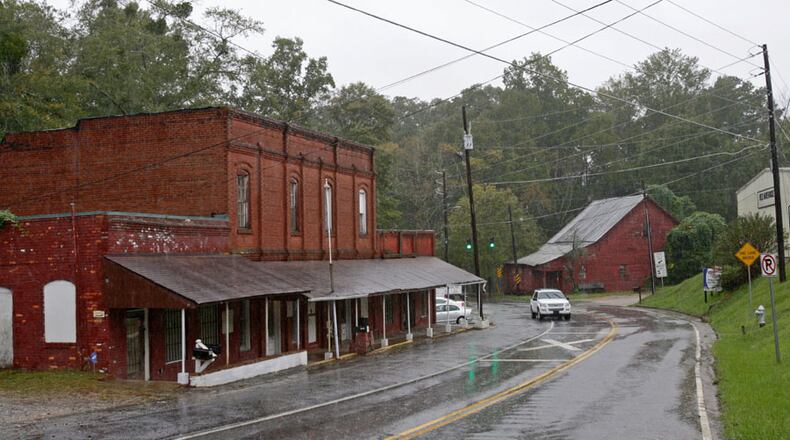Rex, Georgia, is so far off the map, say its residents, that GPS doesn't pick it up.
When he orders a new starter-motor for his automotive repair business, Paul Abraham jokes that he waits until the delivery truck is nearby and then “I send up a smoke signal.”
Rex Road once funneled plenty of cut-through traffic to the village, but a bypass opened this year re-routing most of those cars. As Abraham stood under the dripping awning of a 1920s storefronts on a recent rainy day, the only passing vehicles were freight cars on the railroad lines running right through the village.
But help for Rex may be on the way, from an unlikely source: A six-year-old slave named Melvinia, with friends in high places.
In the 1850s Melvinia worked on a 200-acre farm just outside the village, owned by Henry Shields. Genealogists contracted by the New York Times tracked Melvinia's lineage, through her biracial son Dolphus Shields, and discovered that her great-great-great granddaughter is Michelle Obama.
"I got chills up and down my spine when I read it," said Denise Seltz, who lives in Rex with her husband Darryl. "Now I feel like we're ‘this' close," she said, holding two fingers a millimeter apart.
Credit: Georgia Archives
Credit: Georgia Archives
"This is actually very exciting," said Gayle Beddingfield, who, with her husband, Jerry, owns the 160-year-old mill that is the centerpiece of the tiny village. "It sheds more history on Rex that none of us knew."
The news couldn't come at a better time. With the help of Clayton County's economic development director Grant Wainscott, Rex's business leaders are planning a campaign to restore Rex's 100-year-old commercial buildings -- including a cotton gin, a mercantile building and the mill.
They hope to capitalize on its small size, its bucolic setting and its one-of-a-kind structures to generate tourism. They think a connection to the White House might help.
The residents of Rex realize, however, that the story of Melvinia has a tragic side.
At age 6 she was sent to the Shields farm, hundreds of miles from where she grew up in South Carolina. She gave birth to her first child while still a teenager -- perhaps as young as 15. The father was a white man, though whether he was Henry Shields, one of Henry's sons or another man, has not been established.
"Life was very hard," said Gene Hatfield, a retired history professor at Clayton State University. "It was pretty unremitting labor."
When the Battle of Jonesboro broke out in 1864, Melvinia could have seen the smoke from the Jonesboro buildings going up in flames and heard the roar of the cannon, says Jim Sherling, director of the Genealogical Society of Henry and Clayton Counties.
Sherling helped research the Times piece and discovered the records that established Melvinia as a part of the Shields estate, he said. Technically the Shields residence was in Jonesboro, though they were buried in Rex, he said. He knows of, but prefers not to name, one descendant. The Obamas chose not to comment for the Times story.
"The thing that kind of brought tears to my eyes, was when I read that she was only worth $475," said Naomi Gilson, who operates a custom drapery and upholstery business, the House of Naomi, in the historic cotton gin building. "But it makes me want to be pressing on to do better things."
Credit: Johnny Crawford
Credit: Johnny Crawford
Paul Abraham is the director of an association of Rex Village business leaders. He says that Melvinia's doughty ability to survive -- she lived to age 90 -- can serve as an inspiration to his community, and that her life, even with its pain, should be celebrated. "All that is history, whether good or bad, it’s still history," he said. "And it's still here! It's something we can put a finger on."
The mill on Cotton Indian Creek dates back to the 1830s, though it has been reconstructed since then. Dr. William Callaway Estes bought the mill from the Hollingsworth family in 1887, and used power from the mill to operate a factory that produced farm implements called grain cradles.
(Local lore has it that the Hollingsworths named the village after their favorite dog, Rex.)
Estes' factory eventually became a furniture factory and the mill was used to grind corn until the 1960s. His son, Walter Estes, served as a state senator, ran the furniture business and the mill, operated a bank and owned most of the property in the area. The park that contains Rex's brand-new 60,000 square-foot recreation center is named after the younger Estes.
Over the years the mill pond has attracted picnickers and church baptisms, and Margaret Mitchell's family from nearby Jonesboro were visitors.
According to the Times story, the Shields farm is under one of the many subdivisions that have spread around the outskirts of the village.
While the Rex Road bypass has been hard on business owners, it has also reduced the noise and danger of the traffic jams once caused by the village's picturesque one-lane bridge. The village encompasses about 20 structures, but 4,000 people live within a mile radius of the village, a majority African-American.
Wainscott envisions a farmer's market, a history center, walking paths along the creek, perhaps antiques emporiums and bed and breakfasts. Six miles from the nation's busiest airport would be a whole village restored to its late 19th century prime. This transformation would cost millions, and would require public funding, said Wainscott.
"It would be wonderful," said Gayle Beddingfield. "It gives us a lot of new hope in that maybe people will want to discover the area and see it restored."
About the Author
The Latest
Featured




